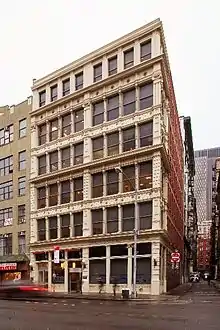Charles B. Wang Community Health Center
The Charles B. Wang Community Health Center (CBWCHC), founded in 1971, is a nonprofit organization and Federally Qualified Health Center.[1] The Health Center provides primary health care to members of the community with a focus on Asian Americans. There are locations in Lower Manhattan and Flushing, Queens, all which are opened 7 days a week. In 2016, the Health Center served more than 52,000 patients and 280,000 service visits. The Health Center has multilingual staff fluent in Mandarin, Cantonese, Taishanese, Shanghainese, Hokkien, Vietnamese, and Korean. The Health Center serves all patients regardless of language, culture or ability to pay.
| Charles B. Wang Community Health Center | |
|---|---|
| Federally Qualified Health Center | |
 Location on Canal Street | |
| Geography | |
| Location | 268 Canal St, New York, NY 10013 125 Walker St, New York, NY 10013 168 Centre St, New York, NY 10013 136-26 37th Ave, Flushing, NY 11354 137-43 45th Ave, Flushing, NY 11355 |
| Links | |
| Website | http://www.cbwchc.org |
History
CBWCHC started in 1971 by a group of volunteers who organized the Chinatown Health Fair to provide health education and screenings to the medically underserved Chinese community in New York City. About 2,500 community members participated in the fair. Following the tremendous community response, the volunteers organized a free clinic in space donated by the Church of Our Savior on Henry Street.
As the free clinic grew, donations funded the expansion to a new location at 89 Baxter Street in 1979.[2] With this new location, more patients were being seen and treated. This new location was opened seven days a week with a full staff of doctors and nurses. Now with a stable structure, patients were able to return for check-ups and continual care.
As part of Lydon Johnson Administration's War on Poverty, neighborhood health centers were created to provide health and social services in poor and underserved communities. Through the 1970s, Congress authorized funding for community, migrant, and public housing health centers. In 1989, Congress passed the Omnibus Budget Reconciliation Act which consolidated these funding streams and created the Federally Qualified Health Centers (FQHC) program.[3] This allowed qualified health centers to fully cover the cost of treating uninsured patients. With this Public Health Service Act, the Health Center was more capable of providing care to a larger scope of the community.
Services
| Internal Medicine | Primary care for patients 18 and over, check-ups, immunizations, nutrition counseling, screening and treatment for cholesterol, diabetes, high blood pressure, sexually transmitted infections, smoking, cancer, hepatitis B care program, specialty care in optometry, urology, hematology, pulmonology, nephrology |
| Pediatric Care | Primary care for patients 21 and under, check-ups, immunizations, nutrition counseling, and specialty care. |
| Obstetrics and Gynecology | GYN, breast/cervical/colorectal cancer screening, HPV testing and vaccinations, HIV/STD testing, pregnancy testing, prenatal and postpartum care, delivery at partner hospitals, breastfeeding education |
| Dental Care | Teeth cleaning, dental x-rays, dental fillings/crowns, tooth extraction, root canals, periodontal treatment, denture and bridge care |
| Mental Health | Diagnostic and treatment assessment for disorders, medication management, individual and group therapies, urgent assessment, intervention management of behavioral aspect of medical diseases, screening for depression |
| Social Services | Family counseling, crisis intervention, case management, assistance with government benefits |
| Health Education | Chinese/English language health education materials, public group workshops, counseling on health |
| Additional Services | Women, Infants, and Children (WIC) program, health insurance enrollment, optometry services, nutrition counseling, language access line, Patient Portal |
References
- Hoobler, Dorothy and Thomas (2011). From Street Fair to Medical Home. HSU+Associates. p. 21.
- Hoobler, Dorothy and Thomas (2011). From Street Fair to Medical Home. HSU+Associates. p. 68.
- Hoobler, Dorothy and Thomas (2011). From Street Fair to Medical Home. HSU+Associates. p. 78.